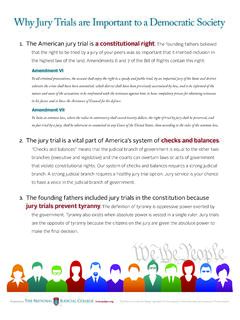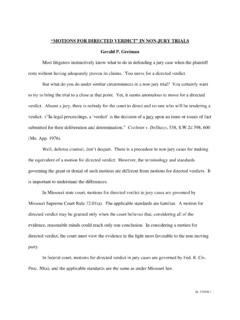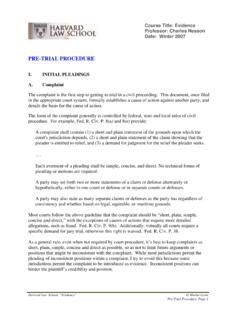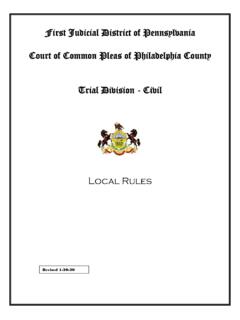Transcription of Ninth Circuit Manual of Model Jury Instructions Civil
1 Ninth Circuit Manual ofModel jury InstructionsCivil2007 INTRODUCTIONThis Manual of Model Civil jury Instructions ( Manual ) has been prepared to helpjudges communicate effectively with Instructions in this Manual are models. They must be reviewed carefully before usein a particular case. They are not a substitute for the individual research and drafting that may berequired in a particular case, nor are they intended to discourage judges from using their ownforms and techniques for instructing juries. See McDowell v. Calderon, 130 833, 840 (9thCir. 1997).The jury Instructions Committee considers suggestions from judges, staff andpractitioners about possible revisions, additions and deletions. After careful assessment andresearch, many of these suggestions are adopted. Revisions are available online. They are latercompiled and published in the printed version of the Manual . The committee stronglyencourages users of this book to make suggestions for further revisions and updates.
2 Asuggestion form has been included in the back of this book for that Manual is periodically reprinted. Publication of any edition of the Manualnecessarily presents a snap-shot of an ongoing research and drafting process. Accordingly, eventhe most recently dated edition of the Manual does not guarantee that one is using instructionsthat are up to date. All Instructions in this edition are coded to indicate the year they were lastapproved by the Committee. The code appears at the bottom of the page upon which aninstruction appears ( Approved 2006 ). Users of the Manual should check the date todetermine when an instruction was last approved. The entire publication and any later changescan be found under the Publications area of the Ninth Circuit s website . This edition is current as to Instructions approved in edition contains a substantial revision and reorganization of many chapters. Forexample, former Chapters 1-5 have been reorganized as three chapters: Chapter 1 ( Instructionson the Trial Process ), Chapter 2 ( Instructions on Types of Evidence ), and Chapter 3( Instructions on Deliberations ).
3 Chapter 9 ( Civil Rights Actions 42 1983 ) andChapter 10 ( Civil Rights Title VII Employment Discrimination; Harassment; Retaliation )have been substantially revised and expanded. To assist users, the committee has included atable listing the old instruction numbers in the 2001 edition and the corresponding numbers inthe 2007 Model Instructions have been reviewed by various members of the federal benchand bar. The committee extends its thanks to those who reviewed and commented on variousparts of the book. The committee also extends its thanks to Ninth Circuit Office of the CircuitExecutive staff members Robin Donoghue and Debra Landis. In addition, the committee acknowledges with gratitude the singular contributions of Joseph Franaszek, Esq. For manyyears, Mr. Franaszek has worked with the committee on a voluntary basis, providing carefulresearch and drafting assistance, as well as a unique institutional memory that enables the2shifting members of the committee to understand how existing Instructions came to beformulated.
4 Mr. Franaszek has performed an invaluable service to the Ninth Circuit and the Barand has earned the committee s enduring respect. CAVEATT hese Model - jury Instructions are written and organized by district judges and magistratejudges who are appointed to the Ninth Circuit jury Instructions Committee by the Chief CircuitJudge. The judges on the Ninth Circuit Court of Appeals do not serve on the committee,however, and they do not participate in the drafting process. The Court of Appeals does notadopt these Instructions as definitive. Indeed, occasionally the correctness of a given instructionmay be the subject of a Ninth Circuit Circuit jury Instructions COMMITTEEJ udge George H. King, Chair Judge Marsha J. PechmanJudge Anna J. Brown Magistrate Judge Richard SeeborgJudge Roger L. Hunt Joseph Franaszek, Reporter Judge A. Howard Matz Robin Donoghue, StaffJudge Jeffrey T.
5 Miller Debra Landis, StaffSeptember, 200634 jury INSTRUCTION NUMBERSCONVERSION TABLE2001 EDITION2007 of jury of jury (Court Reads and Provides Written Set ofInstructions) of jury (Court Reads Instructions Only) of jury (Court Reads and Provides Written Set ofInstructions at End of Case) and Is Is Not for Limited and Circumstantial on of of the Transcript Available to of of Proof Preponderance of the of Proof Clear and Convincing to Witnesses by to Be Guided by Official EnglishTranslation/Interpretation of Instruction First Recess Conferences and of as Substantive of Tape of Recording in Foreign Language Purpose by Conviction of and of Interrogatories of a of jury to Find Facts and Follow Is Is Not to be Guided by Official and Circumstantial of Evidence, Expert Causation (Comment only) and Summaries Not Received in and Summaries in or More Parties Different Legal Rights Evidence to of With Court of Instructions of of Proof Preponderance of the of Proof Clear and Convincing Complete Affirmative and Partnerships Fair of Corporations Scope of Authority Not of Partnerships Scope of Authority Not and Principal Scope of Authority of Agent Is Act of Principal Scope of AuthorityNot in Principal and Agent Sued No Issue as to Agencyor Sued but Not Agent No Issue as to Agencyor Principal and Agent Sued Agency or Sued, but Not Agent Agency or Contractor Partnership Partnership Scope of Partnership Partnership Act of Partner Is Act of Partnership Liability of Partner No Issue asto Partnership, Agency.
6 Or Scope of Existence Admitted Scope of PartnershipBusiness in Issue Existence of Partnership in Issue of Types of Arising in the Future Discount to PresentCash jury Instruction for Federal Employers Liability Act (45 51 and 53) Elements and Burden of Negligence Plaintiff s Compliance With Defendant'sRequest or Damages (Comment only) Plaintiff s Negligence Reduction of Damages(45 53) Act Negligence Claim Elements and Burden ofProof (46 30104) Act Negligence Act Negligence Claim Act Plaintiff s Compliance With Defendant'sRequest or Claim Elements And Burden or Unseaworthiness Damages Proof(Comment only) or Unseaworthiness Plaintiff'sNegligence Reduction of And Cure Elements and Burden of And Cure Willful or Arbitrary Failure Refund Actions Elements and Burden ofProof Claimed Refund Actions Elements and Burden ofProof Claimed of Federal Civil Rights Elements andBurden of Color of Law Defined 1983 Claim Against Supervisory Defendant inIndividual Capacity Elements and Burden of Proof Rights First Amendment PublicEmployees Speech Rights First Amendment Citizen Immunity (Comment only)
7 , Force Unreasonable Seizure Lawful Search Search Exceptions to WarrantRequirement Search Incident to Lawful Search Exceptions to WarrantRequirement Search Exceptions to WarrantRequirement Exigent Circumstances Rights Fourth Amendment UnreasonableSearch Exception to Warrant Requirement Emergency or Community Caretaker Circumstances Rights Fourth Amendment UnreasonableSeizure of Property Generally11 Rights Fourth Amendment UnreasonableSeizure of Property Exception to WarrantRequirement Rights Fourth Amendment UnreasonableSeizure of Person Generally Rights Fourth Amendment Unreasonable Seizure of Person Exception to WarrantRequirement Terry Stop Rights Fourth Amendment Unreasonable Seizure of Person Probable Cause Arrest Rights Fourth Amendment UnreasonableSeizure of Person Detention During Execution ofSearch of Prisoner s Federal Civil Rights EighthAmendment Excessive of Prisoner s Federal Civil Rights EighthAmendment General Conditions of of Prisoner s
8 Federal Civil Rights EighthAmendment Medical Policy Makers 1983 Claim Against Local Governing BodyDefendants Based on Ratification Elements andBurden of Liability Failure to Train Elements andBurden of Rights Title VII Disparate Treatment Elementsand Burden of Proof (42 2000e) , Rights Title VII Disparate Treatment MixedMotive Case (42 2000e) Rights Title VII Disparate Treatment WhereEvidence Supports Sole Reason or MotivatingFactor Rights Title VII Disparate Treatment SoleReason Elements and Burden of Proof Rights Title VII DisparateTreatment Motivating Factor Elements and Burdenof Proof Rights Title VII Hostile WorkEnvironment Harassment (Comment only) Rights Title VII Hostile WorkEnvironment Harassment Because of Protected Characteristics Elements Rights Title VII Hostile Work EnvironmentCaused by Supervisor Claim Based upon VicariousLiability Tangible Employment Action AffirmativeDefense Rights Title VII Hostile Work EnvironmentCaused by Non-Immediate Supervisor or by Co-Worker Claim Based on Negligence Rights Title VII Retaliation Elements andBurden of Proof Rights Title VII Definition of Common Terms(Comment only)
9 Rights Title VII Adverse Employment Action 13 Rights Title VII Adverse Employment Action in Retaliation Cases Rights Title VII Adverse Employment Action in Disparate Treatment Cases Rights Title VII Tangible EmploymentAction Defined Rights Title VII Constructive Discharge Rights Title VII DisparateTreatment Affirmative Defense Bona FideOccupational Qualification Rights Title VII DisparateTreatment Affirmative Defense Bona Fide Rights Title VII Same Decision Work Environment SexualHarassment Work Environment Sexual Harassment bySupervisor Adverse Tangible Employment Tangible Employment Action Hostile Work Environment Sexual Harassment bySupervisor No Adverse Tangible EmploymentAction Affirmative Work Environment Sexual Harassment Quid Pro Quo Sexual Harassment Essential Quid Pro Quo Sexual Harassment Defense Non-Discriminatory Reason Essential Retaliation Defense Non-Retaliatory Reason Pretext(Comment only) Discrimination Disparate Decision After-Acquired Discrimination Disparate Treatment Elementsand Burden of Proof Discrimination Disparate Treatment Elementsand Burden of Proof Failure or Refusal to Hire NoAffirmative Defense Discrimination Disparate Treatment WhereEvidence Supports Sole Reason or MotivatingFactor Discrimination Disparate Treatment SoleReason Elements and Burden of Proof Discrimination Disparate Treatment MotivatingFactor Elements and Burden of Proof Discrimination Disparate Treatment HostileWork Environment (Comment only) Discrimination Retaliation (Comment only) Discrimination Disparate Treatment AffirmativeDefense Bona Fide Occupational Discrimination Disparate Treatment AffirmativeDefense Bona Fide Seniority System15 Discrimination Disparate Treatment After-Acquired Evidence (Comment only)
10 Discrimination Disparate Treatment AffirmativeDefense Bona Fide Employee Benefit Discrimination Disparate Impact Elements andBurden of Proof Age Discrimination Disparate Impact AffirmativeDefense Business Necessity Discrimination Defense Reasonable Factor OtherThan Discrimination Damages Compensatory Reduction Age Discrimination Instruction ADA Employment of ADA Employment Action Employment Actions Where Evidence Supports Sole Reason or Motivating Factor Employment Actions Sole Reason Elementsand Burden of Proof Employment Actions MotivatingFactor Elements and Burden of or Mental as a Major Life or Mitigated to Perform Essential Functions Necessity as a Direct (Comment only) 301 Duty of Fair Representation Elementsand Burden of Proof Hybrid 301 Duty of Fair Representation HybridClaim Instruction Trademark Dress Defined (15 1125(a)) Trade Name/Commercial Name Liability Theories and , Elements and Burden ofProof Trademark or Trade Dress Elements and Burden of Proof Elements Presumed Validity andOwnership Registered Elements Validity Elements Validity UnregisteredTrademark Elements Validity Distinctiveness Secondary Elements Validity Trade Dress Non-Functionality Elements Ownership Ownership Ownership Ownership Merchant or Elements Likelihood ofConfusion Factors Sleekcraft of Confusion Factor Strength orWeakness of Infringement Elements and Burden of Infringement Elements and Burden Abandonment AffirmativeDefense Defendant s Burden of Continuous Prior Use Within RemoteGeographic Area Affirmative Classic Fair Use Nominative Fair Damages Actual or Statutory Damages Plaintiff's Actual Damages Defendant s Damages Intentional Instruction Defined (17 106) Subject Matter (17 102) Subject Matter Ideas and Expression ( 102(b))







